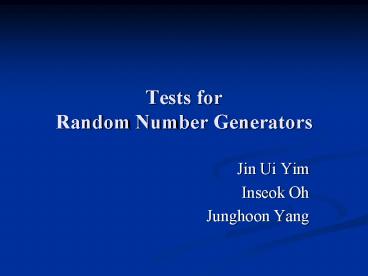Tests for Random Number Generators - PowerPoint PPT Presentation
1 / 23
Title:
Tests for Random Number Generators
Description:
Random Number Generators. Jin Ui Yim. Inseok Oh. Junghoon Yang ... Methods to test random numbers. Frequency test (Uniformity) Uses the chi-square test to compare ... – PowerPoint PPT presentation
Number of Views:297
Avg rating:3.0/5.0
Title: Tests for Random Number Generators
1
Tests for Random Number Generators
- Jin Ui Yim
- Inseok Oh
- Junghoon Yang
2
Desirable properties of random numbers
- Uniformity
- Independence
3
Methods to test random numbers
- Frequency test (Uniformity)Uses the chi-square
test to comparethe distribution of the set of
numbers generated to a uniform distribution. - Autocorrelation test (Independence) Tests the
correlation between numbers and compares the
sample correlation to the expected correlation,
zero.
4
Frequency test (Chi-Square Method)
- Oi - the observed number in the ith class
- Ei - the expected number in the ith class
- n - the number of classes
5
Frequency test (Chi-Square Method)
- For the uniform distribution, Ei , the expected
number in each class is given by for equally
spaced classes.
- N - the total number of observations
- n - the number of classes
6
Generating random number source(1)
double data new double100 //This object
generates random number between 0 and 1 Random
randomGenerator new Random() for ( int n 0
n lt 100 n ) //Makes random number x
randomGenerator.nextDouble() datan x
7
Generated random number
0.34 0.90 0.25 0.89 0.87 0.44 0.12 0.21
0.46 0.670.83 0.76 0.79 0.64 0.70 0.81
0.94 0.74 0.22 0.740.96 0.99 0.77 0.67
0.56 0.41 0.52 0.73 0.99 0.020.47 0.30
0.17 0.82 0.56 0.05 0.45 0.31 0.78
0.05 0.79 0.71 0.23 0.19 0.82 0.93 0.65
0.37 0.39 0.42 0.99 0.17 0.99 0.46 0.05
0.66 0.10 0.42 0.18 0.49 0.37 0.51 0.54
0.01 0.81 0.28 0.69 0.34 0.75 0.49 0.72
0.43 0.56 0.97 0.30 0.94 0.96 0.58 0.73
0.05 0.06 0.39 0.84 0.24 0.40 0.64 0.40
0.19 0.79 0.62 0.18 0.26 0.97 0.88 0.64
0.47 0.60 0.11 0.29 0.78
8
Chi-Square Test Source(1)
9
Chi-Square Test Source(2)
10
Frequency test
- The chi-square test conducted with a0.05 to test
for whether the randomly generated data are
uniformly distributed.
- The null hypothesis of a uniform distribution is
not rejected when the result of chi-square is
smaller than the tabulated value.
11
Frequency test
- double resultOfChiSquareTest ChiSquareTest(
data ) - if( resultOfChiSquareTest lt 16.9)
- System.out.println("The null hypothesis of a
uniform distribution is not
rejected.") - else
- System.out.println("The null hypothesis of a
uniform distribution is
rejected.")
12
Autocorrelation Use
- Economy- Stock Market
- GIS
- Architecture Engineering
- Information Technology - CDMA
13
Autocorrelation Notion
- The notion is that numbers on the sequence might
be related. - We will select the number with same distance.
14
Autocorrelation
- m - m is the lag, the space between the numbers
being tested. - i - i is the index, or the number in the sequence
that you start with. - N - The number of numbers generated in a
sequence. - M - M is the largest integer such that
- Pim - the estimator that is approxomitely normal
- Qpim - the standard deviation of the estimator
15
AutocorrelationEquation-Schmidt and Taylor
So, We can calculate the k value.
16
AutocorrelationEquation-Schmidt and Taylor
17
AutocorrelationEquation-Schmidt and Taylor
18
Autocorrelation Accept / Reject
ACCEPT
Reject
Reject
19
Autocorrelation Test Source
20
Autocorrelation Test Source(2)
21
Result
- Frequency Tests(Chi-Square)
- a 0.05,X2_0.05.9 16.9
- The result of Chi-Square 4.4
- The null hypothesis of a uniform distribution is
not rejected. - Tests for Autocorrelation
- m 5,i 2
- N 50,M(i(M1)m lt N) 8
- a 0.05,Za/2 1.96
- The result of AutoCorrelation
0.6440408970482641 - The null hypothesis of an autocorrelation is not
rejected.
0.21449970335028734 0.14016906690349618 0.16450305
18088607 0.8638687961841897 0.2909116149745625 0.0
8590384803754958 0.9533828724917218 0.993675376837
7475 0.7388814369469828 0.8008823252683048 0.05016
115669494969 0.3787119891281151 0.4768874088196027
0.34120913234270767 0.02096581516091489 0.8103991
12996363 0.8352798169604146 0.1341231494235261 0.4
0901395536426344 0.9739110447728812 0.871376353677
3295 0.645201328845651 0.27027552460170856 0.92957
96431460743 ...
22
References
- Discrete Event System Simulation 4rd edition
- CH7.1, CH7.4
- http//www.unf.edu/rita0001/research/index.html(F
requency test ) - http//www.itl.nist.gov/div898/software/dataplot/r
efman1/auxillar/freqtest.htm(Autocorrelation Test
)
23
References
- www.math.com
- www.wordiq.com
- www.jstor.org(durbim-watson test)
- http//210.125.93.11/economics/dteco.asp?view1wo
rd???? (economic book) - http//chejucyber.cheju.ac.kr/kanggc/em/chap5/chap
5.hwp (Jeju university)































